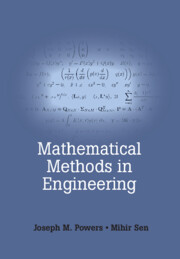Book contents
- Frontmatter
- Dedication
- Contents
- Preface
- 1 Multivariable Calculus
- 2 Vectors and Tensors in Cartesian Coordinates
- 3 First-Order Ordinary Differential Equations
- 4 Linear Ordinary Differential Equations
- 5 Approximation Methods
- 6 Linear Analysis
- 7 Linear Algebra
- 8 Linear Integral Equations
- 9 Dynamical Systems
- Appendix A
- References
- Index
9 - Dynamical Systems
Published online by Cambridge University Press: 05 February 2015
- Frontmatter
- Dedication
- Contents
- Preface
- 1 Multivariable Calculus
- 2 Vectors and Tensors in Cartesian Coordinates
- 3 First-Order Ordinary Differential Equations
- 4 Linear Ordinary Differential Equations
- 5 Approximation Methods
- 6 Linear Analysis
- 7 Linear Algebra
- 8 Linear Integral Equations
- 9 Dynamical Systems
- Appendix A
- References
- Index
Summary
In this chapter, we consider the time-like evolution of sets of state variables, a subject often called dynamical systems. We begin with a brief consideration of discrete dynamical systems known as iterated maps, which are a nonlinear extension of the difference equations posed in Section 4.9 or the finite difference method posed in Example 4.24. We also show some of the striking geometries that result from iterated maps known as fractals. Generally, however, we are concerned with systems that can be described by sets of ordinary differential equations, both linear and nonlinear. In that solution to nonlinear differential equations is usually done in discrete form, there is a strong connection to iterated maps. And we shall see that discrete and continuous dynamical systems share many features.
This final chapter appropriately coalesces many topics studied earlier: discrete systems, ordinary differential equations, perturbation analysis, linear algebra, and geometry. Its use in modeling physical engineering systems is widespread and comes in two main classes: (1) systems that are modeled by coupled ordinary differential equations and (2) systems that are modeled by one or more partial differential equations. Systems of the first type often arise in time-dependent problems with spatial homogeneity in which discrete entities interact. Systems of the second type generally involve time-evolution of interacting systems with spatial in homogeneity and reduce to large systems of ordinary differential equations following either (1) discretization of one or more independent variables or (2) projection of the dependent variable onto a finite basis in function space. The chapter closes with examples that draw problems from the domain of partial differential equations into the domain of ordinary differential equations and thus demonstrates how the methods of this book can be brought to bear on this critical area of mathematics of engineering systems.
Iterated Maps
Similar to the nonlinear difference equation introduced by Eq. (4.610), a map fn : ℝN → ℝN can be iterated to give a dynamical system of the form
This dynamical system is obviously not a differential equation.
Information
- Type
- Chapter
- Information
- Mathematical Methods in Engineering , pp. 497 - 584Publisher: Cambridge University PressPrint publication year: 2015
